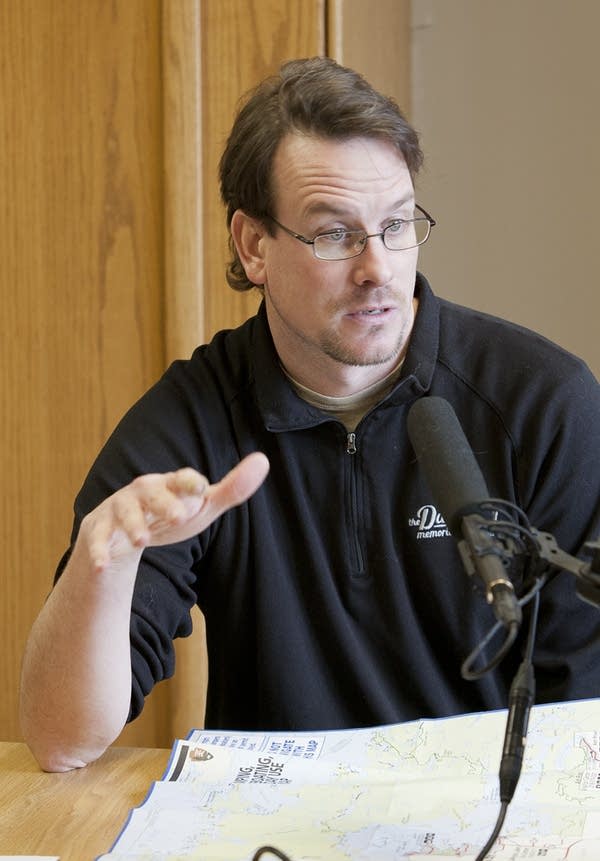Why are Minn. moose dying? Answer sought in Voyageurs Park
Go Deeper.
Create an account or log in to save stories.
Like this?
Thanks for liking this story! We have added it to a list of your favorite stories.

Nearly every week, ranger pilot Steve Mazur flies a small, two-seat plane over the forests of Voyageurs National Park. His mission: to help biologists keep tabs on about 50 moose that live in and around the park.
With 220,000 acres that largely contain lakes and remote, inaccessible wilderness, Voyageurs National Park is big country to cover. With that in mind, researchers have attached GPS collars to 16 moose in the park. The devices could help researchers determine why moose in northeastern Minnesota are dying.
As federal wildlife biologists are wrapping up the first phase of a moose study at Voyageurs National Park, the state Department of Natural Resources plans to collar and track 100 moose in the Arrowhead region to solve the mystery. It will be the largest moose study ever conducted in the state.
Mazur focuses his aerial moose search just east of Rainy Lake on the Kabetogama Peninsula, where the large, dark-furred animals are easy to spot in winter. He spots a moose standing in a thin clump of trees at the edge of a small clearing. It doesn't appear to have a collar on, but that's hard to tell from 2,000 feet.
Turn Up Your Support
MPR News helps you turn down the noise and build shared understanding. Turn up your support for this public resource and keep trusted journalism accessible to all.
• Click for more photos of moose tracking by air
"He's behind a tree," said Mazur, as he circled the plane for a closer look. "There, his head just came out and we're going to fly right over him. It looks like he's looking up at us."
On the ground, researchers are looking for clues as to why Minnesota's moose population has plummeted almost 50 percent in the past six years.
Along with parasites, disease and changing habitat, many scientists agree climate change is a contributing factor. The state's average annual temperature is about two degrees warmer than it was in 1895. Scientists project it will warm another five to nine degrees by the end of the century.

The Voyageurs study focuses on how climate change affects moose behavior and how moose use habitat to avoid warm temperatures.
Early data suggest that when it's hot outside, moose move to spruce bogs or conifer forests with thick canopies that can be close to 10 degrees cooler than out in the open, said Steve Windels, a wildlife biologist at Voyageurs.
Windels said knowing how moose use the habitat to stay cool might help land managers preserve or create those conditions in the future.
"What we really want to get an idea for is how moose respond to weather events, essentially to warm temperatures or other weather events," he said. "And that's the reason for the GPS collars, is to get that really precise information about what habitats are moose using, what times of day are they using them and how does that vary throughout the year."
The GPS collars record ambient temperatures. Biologists also have deployed 90 temperature sensors throughout the park.
After the GPS collars fall from the moose in mid-March, researchers can analyze the data.
Moose numbers in Voyageurs National Park have been relatively stable over the past three decades. But that's not true farther to the east in the Arrowhead region of Minnesota, where seemingly healthy adult moose are dropping dead of unknown causes. In addition, the calf survival rate has dropped to levels that may not sustain the current moose population.

Ron Moen, a biologist with the Natural Resource Research Institute at the University of Minnesota Duluth, said researchers are now out taking blood and other baseline samples from female moose and then fitting them with GPS collars and devices to track what they eat.
If any of those 100 collared moose die, biologists will try to get to them quickly and determine the cause of death, said Moen, who is involved in the Voyageurs study and the DNR moose studies just getting underway.
Another part of the study will focus on calves. When the collared female moose give birth, researchers will collar those calves, too, to monitor their rate of survival.
Moen said climate change will have dramatic effects on moose habitat. Those climate projections mean the future of Minnesota's moose herd is uncertain.
"Fifty years from now, Minnesota will not look like it does now," he said. "And the question is, over the next 10 to 20 years, do we want to do things to keep moose here, and then if they're still here after 20 years, will they still persist after that?
Research shows that land managers could adopt forest management strategies that might help moose in the short term.
But with warming temperatures that are at odds with long-term moose survival in the state, not everyone agrees it will be worth the cost.





